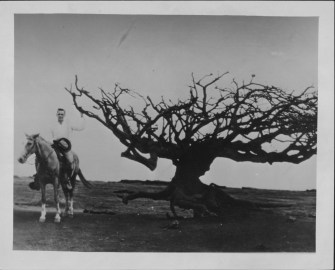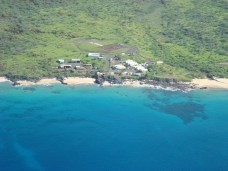Pilot, Ensign John HL Vogt; Radioman-gunner, Third Class Sidney Pierce
Pilot, Petty Officer 2nd Class Koreyoshi Toyama (Sotoyama); Flier 1st Class Hajime Murao
A pair of enemy planes apparently collided on the morning of December 7, 1941 – reports from the scene at the time suggest they also crashed at the same spot on the ʻEwa Plain.
Let’s look back …
In the early morning of December 7, 1941, Japanese pilots flew toward the island of Oʻahu from six aircraft carriers (the Akagi, Kaga, Soryu, Hiryu, Shokaku and Zuikaku;) two attack waves of planes attacked various military installations on Oʻahu (a third group attacked ʻEwa as part of a rear guard action.)
The prearranged coded signal “East wind, rain,” part of the weather forecast broadcast over Radio Tokyo, alerted Japanese Consul General Nagao Kita in Honolulu, and others, that the attack on Pearl Harbor had begun.
The first wave of 183-planes (43-fighters, 49-high-level bombers, 51-dive bombers and 40-torpedo planes) struck its targets at 7:55 am. The second wave of 167-Japanese planes (35-fighters, 54-horizontal bombers and 78-dive bombers) struck Oʻahu beginning at 8:40 am.
Perhaps twenty American fighter planes managed to get off the ground the morning of December 7, 1941. Most of them were shot down, but their actions accounted for six victories in the one-sided aerial battle. (Castagnaro and Padilla)
The USS Enterprise was at sea during the attack, it was shuttling Army Air Force, as well as Navy planes, from West Coast ports to Pearl Harbor, and to outlying detachments on Wake and Guam further west.
She departed on November 28 carrying Marine pilots and their planes to Wake Island, flying them off on December 2 before turning east to return to Pearl Harbor.
Forced to slow by a storm system, which also sheltered the Japanese Combined Fleet advancing on Oʻahu, Enterprise missed her expected return date to Pearl Harbor: December 6. Instead, she was 150-miles west when the Japanese attacked. (CV6-org)
When approaching the Islands, the Enterprise sent out scout dive bombers, which flew in ahead of the ship; unaware of the attack, they were caught in the initial Japanese attack.
One of those was a ‘Dauntless’ manned by Ensign John HL Vogt (pilot) and Third Class Sidney Pierce (radioman-gunner.) Vogt had become separated from his section leader during the Pearl-bound flight in from the carrier; he may have circled off-shore, and then arrived to encounter the dive bombers near ʻEwa. (Cressmand & Wenger)
The Japanese were flying Aichi D3A (Type 99 Navy Dive Bomber – later referred to as ‘Val’ aircraft.) During the Pearl Harbor attack the Japanese dive bombers flew in units of three who looked out for one another.
The Val was the first Japanese aircraft to bomb American targets in WWII. It was the primary dive bomber in the Imperial Japanese Navy, and participated in almost all actions in the war.
One of those was manned by Petty Officer 2nd Class Koreyoshi Toyama (Sotoyama) (pilot) and Flier 1st Class Hajime Murao. Toyama attacked the USS Pennsylvania in Drydock 1. His bomb missed and hit the dock itself. (Cole)
Other than flying over Pearl Harbor, flying back to their aircraft carrier was the second most difficult part of their mission because the air units had to regroup initially over ʻEwa and then proceed to further geographic points – Barbers Point and Kaʻena Point, before heading out to sea northwest of Oʻahu and finding their respective aircraft carriers approximately 200-miles away. (Bond)
Neither of these planes made it back to their respective ships.
One report notes Vogt entered a low altitude dogfight with at least two Japanese planes. He trailed one as best it could until the Japanese plane pulled up sharply and stalled, causing the two to collide in an explosion that brought both plans down. (AECOM)
This was confirmed by Lieutenant Colonel Larkin who saw an American plane and a Japanese plane collide in mid-air a short distance away from the ʻEwa Field. In all probability, Larkin saw the Dauntless collide with a Val. (marines-mil) (Other reports note each was separately shot down.)
The American crew bailed out, but were too low an altitude; both were found dead in the trees when their chutes failed to deploy. Neither of the Japanese crewmen escaped their Val when it crashed. (Cressmand & Wenger)
According to several reports, the two planes ended up in the same spot, at what is today the vicinity of the Hoakalei Golf Course club house. (Bond)
“Investigation disclosed two of our fliers, Ensign JHB Vogt, USNR, and Pierce Sidney, RM 3c, both of the USS Enterprise, were casualties. Two Japanese pilots, both badly burned, were also in the wreck.” (Milz)
Toyama’s two wingmen flew over the crash site, possibly trying to determine if either of the Japanese crew had somehow made it out of the burning crash. They then made a strafing pass before flying away. (Lots of information here from Bond)
The image shows the crash site on the ʻEwa Plain (note the two Japanese support planes circling the site.) (Photographed by Staff Sergeant Lee Embree from a US Army 38th Reconnaissance Squadron B-17E that arrived over Oahu during the Japanese attack. (navy-mil, notation by Bond)
Follow Peter T Young on Facebook
Follow Peter T Young on Google+
Follow Peter T Young on LinkedIn
Follow Peter T Young on Blogger











































